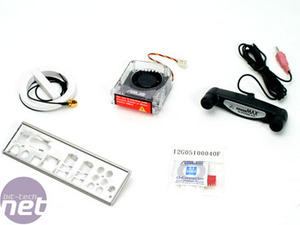Last month, we had a look at Foxconn's NVIDIA nForce 590 SLI reference realisiation and found that it was a pretty good board. However, ASUS also launched at the same time as Foxconn, and we said that we'd reserve our judgement on Foxconn's first real enthusiast motherboard until after we'd looked at the M2N32-SLI Deluxe. We've finally finished putting the ASUS M2N32-SLI Deluxe through its paces, lets find out whether it is worth spending your money on.



 The ASUS SLI Bridge is unique in that it’s floppy. There's an optional fan attaches to the onboard heatpipe fins to keep the board cool.
The ASUS SLI Bridge is unique in that it’s floppy. There's an optional fan attaches to the onboard heatpipe fins to keep the board cool.
The array microphone is a novel idea, where two small microphones are roughly 10cm apart and the ASUS software only picks up sounds from in front of the two microphones, thus negating background noise. For example, if you happen to chat on Skype occasionally, it is an inventive way to make cheap microphones sound better than they actually are. However, it isn't a replacement for a good quality microphone.
A more useful inclusion is the Q-connector, which is a pin extension for the front panel LEDs and switches. Connecting the front panel pin headers is typically the last thing you do when installing your computer in a case. ASUS gives you the opportunity to install the front panel pin headers with less stress by providing an extra plastic pin set with clear labelling for where each pin header should be plugged in. That then plugs into the motherboard, but because the Q-connector is bigger and only goes in one of two possible ways it saves a lot of time and hassle.
Overview:
- Support for all Socket AM2 AMD Athlon 64/FX/X2 and Sempron processors with Cool 'n' Quiet technology;
- ASUS AI Lifestyle including features such as, AI NOS, AI Gear, AI Flash 2, PC Probe 2, O.C. Profile and Crash Free BIOS 3;
- Four DDR2 memory slots supporting up to 8GB of DDR2-800 memory;
- NVIDIA nForce 590 SLI MCP with Link Boost SLI option;
- Dual Gigabit Ethernet;
- Two full-bandwidth PCI-Express x16 slots with SLI support, one PCI-Express x4 slot, one PCI-Express x1 slot and two PCI expansion slots;
- 7.1 channel SoundMax ADI 1998 high definition audio with jack sensing and optical S/PDIF Out;
- Six SATA 3Gbps ports controlled by NVIDIA's SATA RAID controller, supporting RAID 0, 1, 0+1, 5 and JBOD;
- Single ESATA and internal SATA controller provided by Silicon Image including RAID 0 & 1.
- Support for ten USB 2.0 ports (four on back I/O panel and six via on-board pins/expansion brackets, two taken up by WiFi card when used);
- Two IEEE1394a Firewire ports
- WiFi card (that doesn’t take up a PCI slot);
- One ATA133 connector;
- One floppy connector.


Package Contents:
- Six Red SATA cables;
- Three molex to SATA power adapters;
- One black IDE cable;
- One black floppy cable;
- Metal I/O shield;
- Wireless Antenna (for wireless version, such as the one we are reviewing);
- IEEE 1394a PCI I/O module with one six-pin Firewire connector;
- One two-port USB 2.0 PCI I/O module;
- Motherboard CD, drivers and user guide;
- ASUS SLI bridge;
- ASUS Array Microphone;
- ASUS optional fan for on-motherboard passive heatsinks;
- ASUS Q-connector.


The array microphone is a novel idea, where two small microphones are roughly 10cm apart and the ASUS software only picks up sounds from in front of the two microphones, thus negating background noise. For example, if you happen to chat on Skype occasionally, it is an inventive way to make cheap microphones sound better than they actually are. However, it isn't a replacement for a good quality microphone.
A more useful inclusion is the Q-connector, which is a pin extension for the front panel LEDs and switches. Connecting the front panel pin headers is typically the last thing you do when installing your computer in a case. ASUS gives you the opportunity to install the front panel pin headers with less stress by providing an extra plastic pin set with clear labelling for where each pin header should be plugged in. That then plugs into the motherboard, but because the Q-connector is bigger and only goes in one of two possible ways it saves a lot of time and hassle.

MSI MPG Velox 100R Chassis Review
October 14 2021 | 15:04







Want to comment? Please log in.